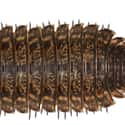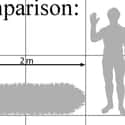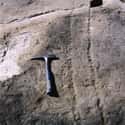-
(#1) It Was The Largest Land-Dwelling Invertebrate In History
The massive Arthropleura flourished from around 320 to 290 million years ago, during the same period when coal deposits laid down rich resources in North America and Europe. While other aquatic arthropods beat Arthropleura in size, no one could match it on land.
But just how big was Arthropleura? Scientists believe it grew to over six feet in length and may have been as much as one-and-a-half feet wide. It was the creepy, crawly king of the forest.
-
(#2) It Had No Known Predators
It's hard to imagine a millipede at the top of the food chain, but Arthropleura had no known predators. Scientists established that fact by looking at the creature's body armor. Researchers Otto Kraus, a millipede expert, and Carsten Brauckmann, a prehistoric arthropod specialist, uncovered the surprising fact that the armor itself was quite thin.
The plating was just a few millimeters thick, and unlike the exoskeletons of modern crustaceans, it did not contain the hard calcium carbonate. This evidence indicates that Arthropleura had few, if any, enemies that tried to catch and eat it.
-
(#3) It Measured Over Six Feet Long
Just how big was Arthropleura, anyway? If an average-height man lay down in the swamps of the Carboniferous Period, an adult Arthropleura could completely cover his body. Scholars believe Arthropleura grew at least two meters in length or the equivalent of over six-and-a-half feet.
They still haven't recovered a complete fossil from the creature, however, so it's possible the prehistoric millipede grew even larger.
-

(#4) It Once Hunted In American Forests
Where did the prehistoric millipede Arthropleura live? About 300 million years ago, many called the current United States home. That's the story scientists uncovered in fossil records. Fossilized Arthropleura remains have been found in Kentucky and New Mexico.
One researcher described the New Mexico tracks left by the massive millipede as similar to tire tracks from a vehicle.
-
(#5) It May Have Been An Apex Predator
In addition to having no known predators, Arthropleura may have been a predator itself. In March Onto Land, author Thom Holmes dives into what the prehistoric millipede ate. While scientists believe Arthropleura likely dined on the decaying organic material that collected on the wet floors of the massive forest, it may have also enjoyed carnivorous meals.
In addition to consuming insects, scientists speculate it may have even hunted small vertebrates unlucky enough to cross paths with the enormous creature.
-
(#6) Scientists Don't Know For Certain What It Ate
The fossilized remains of prehistoric millipedes reveal a great deal about their size, their shape, and how they lived. But there's one thing scientists can't figure out with certainty based on the fossil record: what Arthropleura ate.
Scientists still haven't found the mouth of an Arthropleura, which makes it difficult to establish what the creature ate. It may have been a herbivore, like many modern millipedes, or it may have been carnivorous. From fossilized Arthropleura poop, it looks like the creature ate plants, including ferns.
-
(#7) Its Tracks Alone Show How Massive It Grew
During fossil excavations, scientists sometimes find fossilized tracks from ancient creatures; Arthropleura is no different. In 2001, Michael C. Rygel snapped a picture of the millipede's huge tracks, discovered in Nova Scotia.
The tracks don't just reveal the millipede's size - they also give some clues about the creature's habitat. Some of these prehistoric tracks show Arthropleura skittering around trees in the forests where it thrived.
-
(#8) It Lived In The Coal Swamps Of North America
Arthropleura dominated an era known for its "coal swamps," which occurred during the Carboniferous Period. Around 300 million years ago, much of Europe and North America was covered by lush forests and dense foliage. These wetlands decayed into peat and eventually turned into coal.
On the floors of the wetland forests, Arthropleura would have scurried around, dominating the environment as the largest invertebrate on land.
-
(#9) It Likely Went Extinct Due To Climate Change
Arthropleura was the largest land-dwelling invertebrate ever. But it eventually went extinct, likely due to climate change. The prehistoric millipede flourished due to the higher concentration of oxygen and moist conditions during the Pennsylvanian era. But the climate significantly shifted around 290 million years ago, at the beginning of the Permian period.
The Earth grew drier, making it difficult for Arthropleura to survive. Scientists say Arthropleura's closest modern relatives come from the group Penicillata. Thankfully, none of them grow six feet long.
-
(#10) It Shared Many Characteristics With Modern Millipedes
While it was much longer than today's millipedes, Arthropleura shared some important characteristics with its descendants. For one, it maintained the same ratio of body segments to pairs of legs. The creature had around 30 segments and approximately 40 legs. Like most modern millipedes, Arthropleura had nowhere near the thousand legs its name suggests.
The prehistoric millipede had a somewhat flattened shape, with plates running down the length of its body and side plates reaching out to protect its legs. These pieces often disintegrated after death, making it a challenge to reconstruct the creature with fossil records.
-
(#11) All The Bugs Were Bigger At The Time
It's true: bugs used to be bigger. In Anthropleura's day, it was only one of many enormous insects and arthropods. Take Meganeura, for example, a prehistoric insect that traces its genealogy down to today's dragonflies. At its largest, one variation boasted a wingspan of over two feet, making it one of the biggest insects ever known.
But why did the ancestors of creatures like millipedes and dragonflies grow so much larger? The Earth's atmosphere was significantly different in the past. During the heyday of giant insects, Earth was warmer and wetter, with a higher oxygen concentration - meaning it was the perfect breeding ground for enormous bugs.
-

(#12) Giant Millipedes Are Unlikely To Return
Scientists believe one reason Arthropleura grew so large is because of the higher concentration of atmospheric oxygen about 300 million years ago. But physics means that giant millipedes even larger than Arthropleura are unlikely to plague the Earth.
As vertebrate paleontologist Hans Sues explains, as an arthropod, millipedes are limited by certain size constraints. The creature's exoskeleton means that an arthropod much larger than Arthropleura would not be able to walk due to the required thickness of the creature's leg tubes. And large arthropods also struggle to transfer oxygen throughout their body, which might be one reason Arthropleura vanished when oxygen levels decreased.
-
(#13) Scientists Are Still Searching For A Complete Fossil
Since Arthropleura was named in 1854, scientists have continued chasing a complete, large fossil of the creature. In Germany, they uncovered a partial fossil that was three feet long alone. And in Nova Scotia, scholars found tracks that likely came from Arthropleura and imply the creature was over five feet long.
Those tracks aren't the only clue to Arthropleura's size. Fossil records from enormous armor plates indicate it might grow over six feet long. And scientists may learn even more if they can find a complete version of the creature.
-
(#14) Scientists Still Have A Lot Of Questions About It
While Arthropleura was first identified by scientists back in 1854, there are still many questions about the prehistoric millipede. For example, scientists know very little about the life stages of Arthropleura, including its larval stage. That's because only tracks and partial segments have been found, and scientists still lack a complete adult specimen. The creature's exact head structure also eludes scientists, because, in most fossil remains, the head and jaw area remains incomplete.
The best clues we have about the prehistoric creature come from its tracks, which have been found in numerous locations across Europe and North America. The tracks help establish Arthropleura's massive size, but can't shed light on its other mysteries.
New Random Displays Display All By Ranking
About This Tool
The giant millipede is a kind of prehistoric animal, with a body length of up to 3 meters, and is one of the largest terrestrial arthropods in history. The giant millipede lived in the Carboniferous, because the climate was warm and welt at that time, and the oxygen content was more than 35%, the arthropods at that time could grow very huge. So far, there are more than 10,000 types of millipedes on the earth, and they are distributed all over the world.
The prehistoric giant millipedes are the ancestors of modern millipedes. It’s a pity that these large animals went extinct about 290 million years ago. You can find 14 facts about these prehistoric millipedes that were even not predators.
Our data comes from Ranker, If you want to participate in the ranking of items displayed on this page, please click here.





















